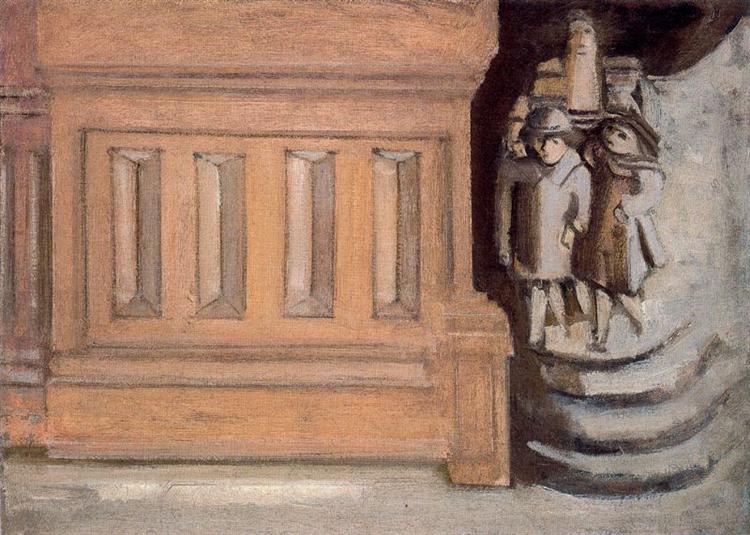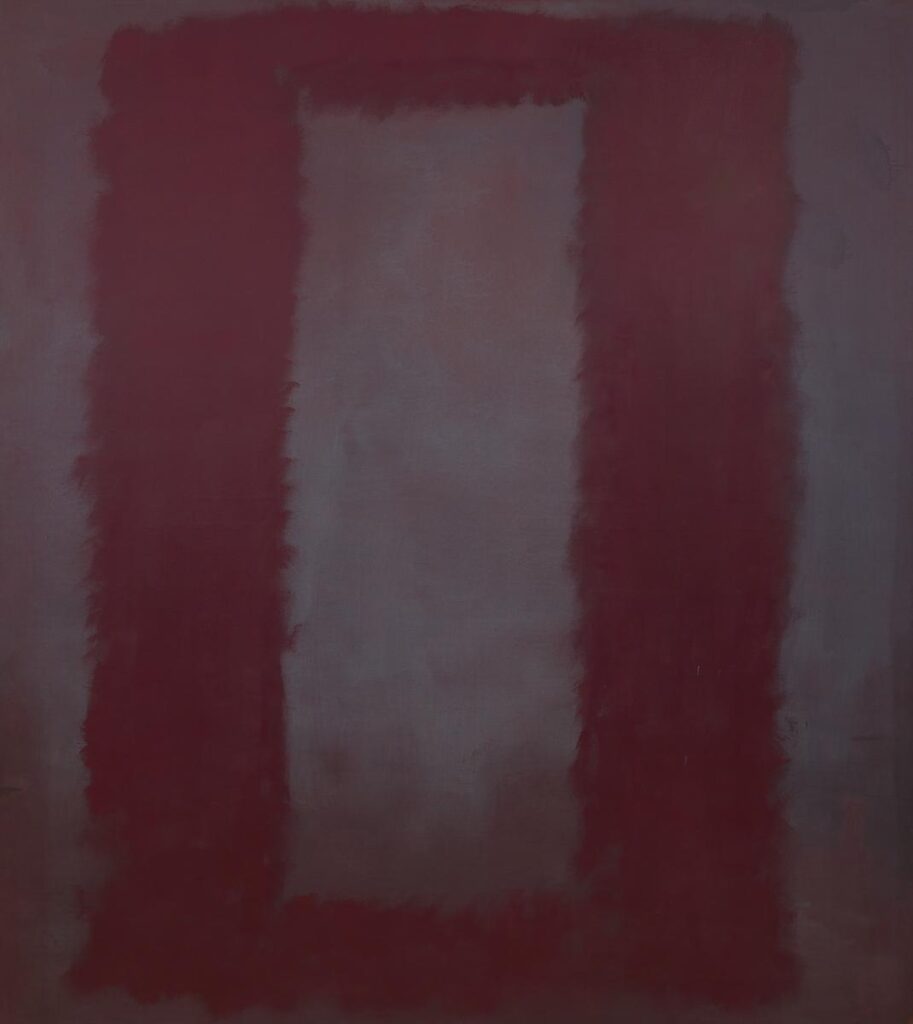The Irascibles: The Birth of American Abstract Expressionism
This photograph of New York-based Abstract Expressionist painters was published in Life magazine in January of 1951. The photograph, dubbed “The...
Tom Anderson 13 February 2025
25 September 2025 min Read
Explaining Mark Rothko’s revolution in painting is almost impossible without experiencing his canvases in person. More than simple rectangles of color, his works are vast emotional spaces that surround the viewer, turning the act of looking into an immersion. From his early city scenes to the haunting Seagram Murals, Rothko’s career traces a journey from figuration to abstraction, always guided by the search for a deeper connection with human emotions.
Talking about Mark Rothko is never easy. His works resist reproduction: no photograph or screen can truly capture what it feels like to stand before one of his monumental canvases. The revolution of Rothko lies in that direct encounter, in the fact that his paintings are not just to be looked at but to be experienced.
For the first time in the history of art, the spectator entered a room and was surrounded entirely by paintings that seemed to absorb the space itself. Rothko didn’t want to decorate walls; he wanted to turn the walls into thresholds for an inner journey. His innovation was not simply the reduction of painting to large rectangles of color—it was the way he invited viewers to immerse themselves, to see their own hidden emotions materialize on the canvas.
After World War II, the art world underwent a seismic shift. Paris, once the home of Impressionism, Cubism, and Surrealism, ceded its role as the capital of the avant-garde. The new center became New York, where a group of artists known as the New York School—including Jackson Pollock, Willem de Kooning, Barnett Newman, and Mark Rothko—pioneered a movement soon called Abstract Expressionism.
Though deeply influenced by European modernism—Monet’s late water lilies, Matisse’s bold colors, Kandinsky’s spiritual abstractions—these American artists charted new territory. Pollock’s canvases captured pure movement through his dripping technique. Rothko, in contrast, sought stillness. Where Pollock expressed energy and gesture, Rothko built silent spaces where viewers could lose themselves.

Mark Rothko, c. 1949. Photography by Consuelo Kanaga, Brooklyn Museum, New York City, NY, USA.
The picture must be… a revelation, an unexpected and unprecedented resolution of an eternally familiar need.
Rothko’s career can be divided into four phases:
Let’s follow this path through five key works.

Mark Rothko, Street Scene, c. 1937, National Gallery of Art, Washington, DC, USA.
In his realist years, Rothko painted scenes of everyday life. Street Scene captures the bustle of New York but with a peculiar emotional undertone. The figures, though ordinary, appear isolated, almost swallowed by the city around them. Even at this early stage, Rothko was less concerned with description than with atmosphere—already searching for ways to evoke the invisible feelings beneath appearances.

Mark Rothko, The Omen, 1943, National Gallery of Art, Washington, DC, USA
By the 1940s, Rothko’s art had shifted. After attending exhibitions of Surrealist and Dada works in New York, he embraced myth and the subconscious. The Omen is a striking example: biomorphic forms float in an ambiguous, dreamlike space. The influence of Max Ernst and Joan Miró is evident, but Rothko’s intent was different. He used mythological and archetypal imagery to search for universal truths, as if painting could touch something eternal amidst the violence of World War II.

Mark Rothko, No. 18, 1946, National Gallery of Art, Washington, DC, USA.
The “multiforms” were Rothko’s transitional works. In No. 18, large areas of color hover and overlap without clear boundaries. The shapes breathe, vibrate, and seem on the verge of dissolving. These paintings are no longer symbolic; they are emotional atmospheres. With them, Rothko prepared the ground for his breakthrough into pure abstraction—color not as form, but as experience.
A painting is not about an experience. It is an experience.

Mark Rothko, No. 13 (White, Red on Yellow), 1958, Gift of The Mark Rothko Foundation Inc., Metropolitan Museum of Art, New York City, NY, USA.
Here, Rothko is at the height of his classical phase. No. 13 consists of glowing fields of yellow, red, and white. But beyond its apparent simplicity lies a profound intensity. The colors seem to emit their own light, surrounding the viewer in warmth and tension at once.
Rothko insisted he wasn’t interested in color harmony for its own sake. His goal was to express “basic human emotions—tragedy, ecstasy, doom.” Standing before this canvas, viewers often report feeling transported into a space beyond words, where color becomes emotion itself.

Mark Rothko, Red on Maroon, 1959, Tate Modern, London, UK. © Kate Rothko Prizel and Christopher Rothko/DACS 2025.
If Rothko’s other works open windows into inner landscapes, the Seagram Murals close them. Commissioned for the Four Seasons Restaurant in New York, the series consists of dark maroons and blacks, structured like looming portals or blocked windows. Rothko ultimately refused to deliver them—he realized that their brooding presence would suffocate the glittering atmosphere of an elite dining room.
Today, housed at Tate, they are displayed in a dedicated space as the artist intended. Entering the room, one feels trapped. The deep colors press in, the dark forms resemble windows bricked over, as if the paintings themselves are walls that confine us. The sensation is that of being imprisoned, looking outward but finding no escape. It is an overwhelming emotional experience—claustrophobic, oppressive, yet profoundly human.
This feeling of oppression found its most powerful expression in the Rothko Chapel in Texas.
Silence is so accurate.
Mark Rothko died in 1970, but his vision reshaped modern art. He helped move the avant-garde from Paris to New York, transformed abstraction into a vehicle of human emotion, and pioneered immersive art environments decades before they became a buzzword.
In the end, Rothko’s true subject was not color or form, but us—the viewers. His paintings confront us with our own hidden depths, forcing us to navigate emotions we might otherwise leave unspoken. Entering a Rothko room is not about looking at art—it is about entering ourselves.
Jacob Baal-Teshuva, Rothko, Taschen 2024.
DailyArt Magazine needs your support. Every contribution, however big or small, is very valuable for our future. Thanks to it, we will be able to sustain and grow the Magazine. Thank you for your help!